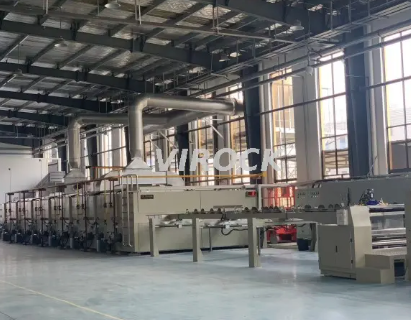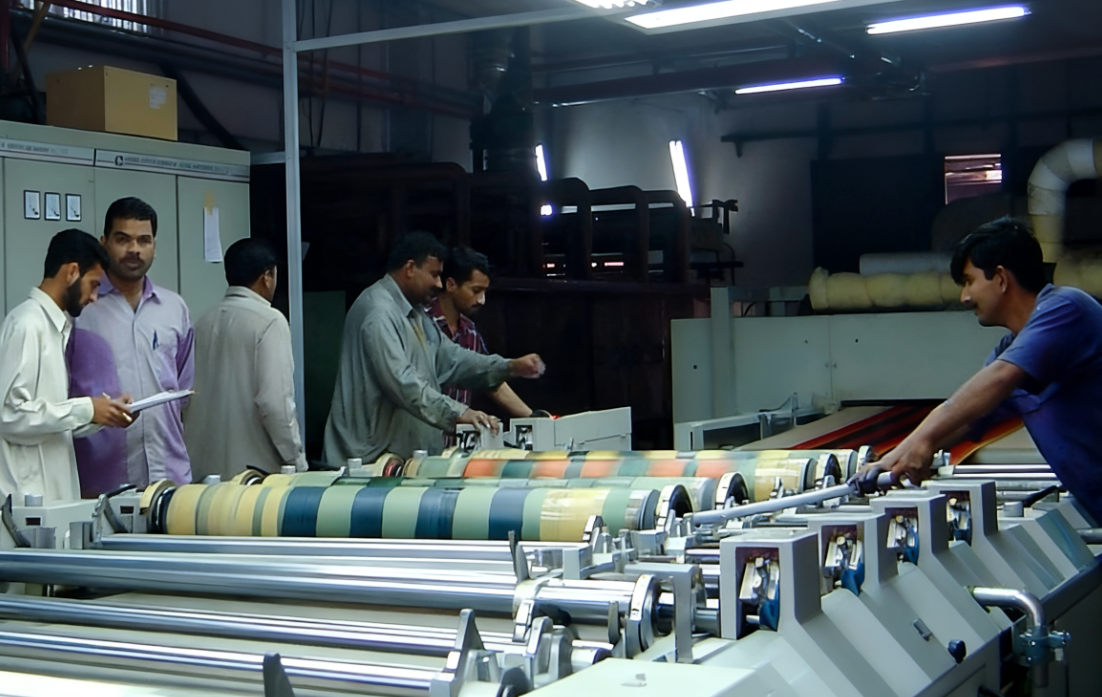Views: 0 Author: Site Editor Publish Time: 2025-10-16 Origin: Site








Textile finishing is the critical final step in fabric production that transforms raw woven or knitted cloth into materials that are ready for market, visually appealing, and functionally enhanced. From softening cotton to creating water-resistant synthetics, finishing processes not only improve appearance and texture but also add crucial performance characteristics such as durability, flame resistance, and antimicrobial properties.
For manufacturers, designers, and buyers, understanding the different types of finishes in textiles is essential. These finishes directly influence how fabrics behave during use, their lifespan, and their suitability for specific applications, ranging from fashion apparel to technical textiles.
Textile finishing encompasses a range of physical and chemical treatments applied to fabrics after weaving or knitting, designed to improve both aesthetic and functional qualities. Fabrics at this stage, often called greige or grey goods, are raw, harsh, and unsuitable for end use. Finishing processes refine these fabrics, making them softer, smoother, stronger, or more resistant to environmental factors.
The purpose of textile finishing can be summarized as:
Enhancing appearance: Brightening, glossing, embossing, or creating decorative patterns.
Improving hand feel: Softening, stiffening, or creating a specific texture for comfort or style.
Boosting performance: Adding water repellency, flame resistance, antimicrobial properties, UV protection, or chemical resistance.

Textile finishes can be broadly categorized into functional, performance, mechanical, and chemical finishes, each playing a distinct role in fabric development.
Functional finishes can either enhance the aesthetic appeal or provide specific protective qualities to the fabric.
Aesthetic Functional Finishes improve visual appeal and tactile properties. Examples include softening to make fabrics more comfortable, raising or napping to create warmth, sueding for a smooth texture, and shearing to remove surface imperfections. These finishes ensure fabrics not only perform well but also meet consumer expectations for look and feel.
Performance Functional Finishes are aimed at protecting fabrics or adding functionality. Fabrics may be treated to resist UV radiation, heat, or electrostatic charges, or to repel insects and microorganisms. These finishes are particularly important for technical textiles, outdoor apparel, and protective clothing.
Performance finishes are distinguished by how long they last and their durability in use:
Temporary finishes offer short-term benefits and typically wash away after a few cycles. They include treatments like starch-based softeners, optical brighteners, and light glazing agents. Temporary finishes are ideal for fashion fabrics where short-term effects are sufficient.
Semi-durable finishes last through several washes, often providing functional properties like water repellency or temporary flame resistance. Wax-based coatings or chemical emulsions create a protective layer that enhances the fabric’s resistance to moisture or fire.
Durable finishes are long-lasting and often achieved through chemical alterations of the fiber structure. These finishes include resin treatments for crease recovery, anti-shrink finishes for cotton, and flame-retardant coatings. Durable finishes are critical for fabrics used in workwear, upholstery, or technical textiles, where longevity and performance are key.
Mechanical or dry finishes alter fabric properties through physical processes, often improving texture and appearance. Common techniques include:
Calendering, which passes fabric through heated rollers to achieve a smooth, polished surface with a subtle sheen.
Sanding, which abrades the surface for a soft, matte, or worn effect.
Glazing, which combines starch, shellac, or glue with heat to create a shiny, reflective finish.
Decating, which shapes and sets fabrics like wool to prevent shrinkage and improve drape.
These mechanical processes are often temporary or semi-durable but play a critical role in defining the visual and tactile character of fabrics before additional chemical treatments.
Chemical or wet finishes provide long-lasting alterations to fiber structure, enhancing both functionality and durability. Key chemical finishes include:
Mercerizing, a treatment for cotton that increases fiber strength, improves luster, and enhances dye absorption.
Anti-microbial finishes, which inhibit bacterial growth, making fabrics suitable for medical textiles, sportswear, and bedding.
Anti-static finishes, which reduce static buildup in synthetic fabrics.
Parchmentizing, which stiffens cellulose fabrics, often used for decorative purposes or functional applications like filters or industrial cloth.
Chemical finishes can also provide waterproofing, flame retardancy, UV protection, and soil release properties, which are essential for both fashion and technical textiles.
| Finish Type | Description | Examples |
|---|---|---|
| Functional Finishes | Enhances aesthetic appeal or provides specific protective qualities | Softening, raising, sueding, shearing, UV resistance, insect repellency |
| Aesthetic Functional Finishes | Improves visual appeal and tactile properties | Softening, raising or napping, sueding, shearing |
| Performance Functional Finishes | Protects fabrics or adds functionality | UV, heat resistance, insect and microorganism repellency |
| Performance Finishes | Distinguished by duration and durability in use | Temporary, semi-durable, durable finishes |
| Temporary Finishes | Offers short-term benefits, wash away after few cycles | Starch-based softeners, optical brighteners, light glazing agents |
| Semi-durable Finishes | Last through several washes, often functional | Water repellency, temporary flame resistance |
| Durable Finishes | Long-lasting, achieved through chemical alterations of fiber structure | Resin treatments, anti-shrink finishes, flame-retardant coatings |
| Mechanical Finishes | Alters fabric properties through physical processes | Calendering, sanding, glazing, decatizing |
| Chemical Finishes | Provides long-lasting alterations to fiber structure | Mercerizing, anti-microbial, anti-static, parchmentizing |
In the textile industry, finishing of textile fabrics is crucial for enhancing appearance, texture, and functionality. Beyond standard finishes, several specialized processes are applied to refine fabrics for specific purposes.
Bleaching is a fundamental textile finishing step that removes natural pigments, stains, and residual manufacturing impurities. It creates a bright, clean surface suitable for dyeing, printing, or decorative treatments. Fabrics like cotton, wool, and silk benefit most from bleaching, while synthetic fibers usually retain their inherent whiteness. Proper bleaching ensures that the finishing of textile fabrics produces consistent color and visual quality.
Singeing burns off loose fibers and lint to give fabrics a smooth, silky surface. This process prepares the textile for subsequent dyeing or printing and improves overall fabric quality. In textile finishing, singeing is essential for cotton and blended fabrics, ensuring a clean and uniform surface free from fuzz.
Shearing is used on napped or pile fabrics to remove surface imperfections and create a uniform texture. Commonly applied to velvet, flannel, and woolen fabrics, shearing enhances both the appearance and hand feel. This step in the finishing of textile fabrics ensures consistency, making the material ready for premium clothing or home textiles.
Beetling compresses linen fibers using wooden mallets, producing a sturdy, polished finish. Often applied to table linens, this traditional textile finishing technique improves both the fabric’s durability and aesthetic appeal. Beetling imparts a subtle sheen and a refined surface that enhances perceived fabric value.
Tentering stretches and dries fabrics to set width and prevent shrinkage. During this process, the textile is held on frames with pins or clips while hot air removes moisture. This step is critical in the finishing of textile fabrics to ensure uniformity and dimensional stability, particularly for cotton, wool, and knit fabrics.
Moire finishing uses embossed rollers to create wavy, watermarked patterns on ribbed fabrics such as silk and satin. This decorative textile finishing enhances visual appeal and reflects light in an elegant way, making fabrics ideal for fashion and upholstery applications.
Embossing applies heated, engraved rollers to fabrics to produce relief designs. Suitable for cotton, polyester, and blends, this finishing of textile fabrics adds texture and style, making textiles more visually appealing and marketable. Embossed patterns are durable and can be incorporated into garments, home textiles, or decorative products.
Pressing removes short hairs and smooths surfaces in wool and other natural fabrics. This textile finishing process gives fabrics a refined, polished look and improves hand feel. Pressing also prepares materials for additional treatments such as coating, dyeing, or tailoring, ensuring the fabric meets functional and aesthetic requirements.

A: Textile finishes in the finishing of textile fabrics are generally classified into temporary, semi-durable, and durable finishes. These can be applied through mechanical processes like calendering or embossing, or chemical processes such as anti-microbial or water-repellent treatments, all designed to enhance appearance, performance, and hand feel.
A: Mechanical finishes (dry finishes) involve physical treatments like sanding, pressing, glazing, and calendering to change texture or surface properties. Chemical finishes (wet finishes) use compounds such as resins, softeners, flame retardants, or water-repellent agents to improve performance. Both play a key role in textile finishing and can be combined for superior results.
A: Yes, combining mechanical and chemical finishing processes allows manufacturers to enhance both texture and functional properties of fabrics. For example, a fabric can be glazed for smoothness and treated with a water-repellent chemical simultaneously, achieving a high-quality, multifunctional finished textile.
A: Technical textiles often require specialized finishing of textile fabrics to meet performance standards. Common essential finishes include anti-microbial treatments, flame retardancy, UV resistance, anti-static properties, and chemical resistance, depending on the end-use application.
A: Finishing processes have a direct impact on hand feel and usability. They can soften, stiffen, add gloss, or create a matte surface, influencing comfort, appearance, and overall consumer perception. Proper textile finishing ensures the fabric meets both aesthetic and functional requirements.
In the ever-evolving textile industry, the finishing of textile fabrics plays a pivotal role in determining the quality, appearance, and functionality of the final product. From mechanical processes like calendering, embossing, and pressing to chemical treatments such as anti-microbial, flame-retardant, and water-repellent finishes, each step in textile finishing contributes to the durability, comfort, and aesthetic appeal of fabrics. Understanding these processes allows manufacturers, designers, and buyers to make informed choices and achieve the desired results for a wide range of applications.
As a company deeply involved in the textile machinery industry, we at VIROCK Textile Machinery Co., Ltd. take pride in providing advanced textile finishing machineries that meet the highest standards of precision, efficiency, and reliability. As a trusted textile finishing machinery manufacturer, we specialize in equipment that supports every stage of the finishing of textile fabrics, helping our clients achieve superior quality finishes with consistent performance. From innovative mechanical finishing machines to state-of-the-art chemical finishing systems, our solutions are designed to empower textile producers worldwide.
By leveraging our expertise and cutting-edge textile finishing machineries, we ensure that every fabric not only meets functional requirements but also exceeds expectations in appearance and feel.